Recipe for Redevelopment Success Part 1
Cities Thriving in the Hottest Season of Site Selection Ever Seen
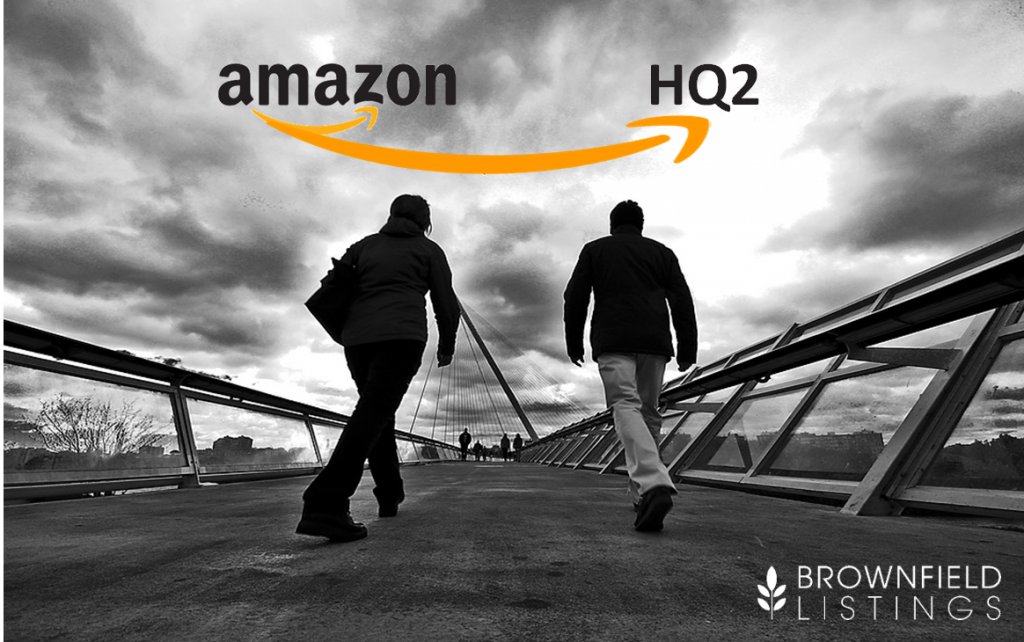
The future is hurtling forward ever-faster, but planning for sustainable success in this young, flux-prone 21st century is a foggy endeavor at best. This long form series by BL slows down the recent record-breaking, game-changing phase of growth by examining the core ingredients in the Amazon HQ2 search that will drive economic development success forward for more than one winning community.
This summer may be the hottest in years, but is the economy even hotter? One of longest economic expansions in modern history just keeps getting longer. Now it’s run out of workers and an acute labor shortage threatens multiple industries. GDP has lagged—only rising above 4% growth 5 times in the post-2008 recovery period, including once in the most recent quarter—but it stands apart from other economic metrics as an underperforming outlier. For years, retail sales, as one example, has outpaced GDP by 1, 2 or more percentage points. In fact, the U.S. has booked the six biggest holiday shopping seasons ever and all in a row recently, with door-busting year-end shopping surges ~4-5% bigger than before.
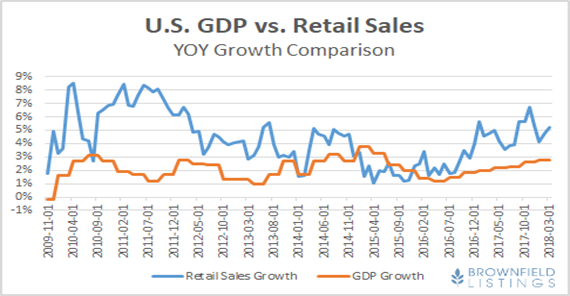
In the rearview mirror, it’s easy to see the major story of the post-2008 period as one of historically steady and quantitative recovery, i.e. retail sales, industrial production, home prices, consumer confidence, et al.
And it’s a powerful story, literally so in the energy sector. The oil boom that began in 2008 has brought on more crude in a shorter period of time than any boom in world history—even more than Saudi Arabia’s golden age following the discovery of Ghawar, the largest oil field ever discovered. This non-conventional carbon boom also brought massive reserves of natural gas into feasible production, driving U.S. electricity prices to among the lowest in the developed world and creating a liquified natural gas (LNG) export rush to sell abundant North American natural gas in global markets.
What’s harder to see through record-breaking retail sales and oil and gas booms, even with the benefit of hindsight, is that the bigger story of the post-2008 period goes beyond the numerical recovery of the old quantitative economy. Rather, the Great Recession’s recovery enabled a structural macroeconomic (or hardware) reset. At the same time, multi-generational demand shifts pivoted towards quality and reformatted consumption behavior (society’s software). Together, this one-two combination knocked the old economy out cold and ushered in a new long era.
Just as the 2008 credit, real estate and commodity triple shock was not the typical downturn, the seemingly slow and steady recovery from the Great Recession has not been the typical recovery. And, as recoveries go, it’s remarkable because it’s built on a series of strong structural economic adjustments of rare quantity and quality. These cascading structural adjustments are creating constructive change throughout the entire value chain, running corporate profits to all time all-time highs and unemployment to generational lows.
And disruptive change.
The future arrived. Yesterday.
Businesses are changing the way they’re doing business and consumers are evolving their preferences at the same time. And it’s pan-generational. Millennials and boomers are both shifting their buying habits, which helps explains why boomers are the fastest growing group of renters. The combined result is a total transformation of business and life. The old rulebooks are quickly becoming obsolete.
As the economy hurtles ever-closer towards the 2020’s, it’s worth stopping to marvel at this moment. It might be hard to notice through the fog of fast-moving modernity, but the “future” has already arrived in many ways. The past, the “old normal” is long gone and a new long cycle has begun.
As a singular example: we’re only eleven years since the introduction of the iPhone now and the ubiquity of connectivity in daily life makes it hard to remember how we functioned before. The internet’s tipping point is now firmly in the rearview mirror and we’re finding a new way forward into that tech-enabled future.
In this long form series, we’ll follow in the footsteps of one of the trailblazer’s forging the new way forward into the 21st century economy, Amazon, to find a path through the fog of the moment. As one of the most indomitable forces in the business world and a multi-category leader, Amazon’s push into its next phase of growth is as forward-thinking a case study as one will find.
This wayfinding is essential in moments of flux, as now, because operating under the old rulebook can be fatal. After only 18 months in operation, the Pony Express became instantly obsolete when, on October 24, 1861. It was the day Western Union completed the first transcontinental telegraph after only 112 days of construction–completing a project even ever-optimist Abraham Lincoln thought was impossible.
Today, the rate of technological progress only compounds. Stare at it too long and it’s easy to become overwhelmed, even disoriented. It’s called future shock. Here, we’ll slow it down and play follow the leader in search of the secret recipe to successful economic development growth and the new rules that will determine who will win the future.
On our journey, we’ll survey the cities we come across in Amazon’s search to site it’s next corporate headquarters, “Amazon HQ2.” And we’ll sort them, as Amazon will, to see how and why some cities have better chances to land the new economy behemoth’s next home.
And some don’t.
Amazon Won the Internet and is Now Coming Full Circle
Jeff Bezos’ brainchild seems to stack breakout year atop breakout year. Disrupting segment after segment, Jeff Bezos is collecting accolades on the order of Warren Buffet dubbing him the greatest business person of his generation. The server business rolled out in 2006, Amazon S3 (Simple Storage Service), is a cash cow and Amazon Web Services (AWS) just produced $6.1 billion in second quarter 2018 revenue, up 49% over the prior year. Amazon’s private label power is luring shoppers away from dominant brands with a snap of its fingers, e.g. AmazonBasics now accounts for one in every three batteries sold online–outselling both Energizer and Duracell on its site.
When Amazon introduced Amazon Prime in 2013, it shifted the long-predictable holiday shopping peak week by a full week. And now, following years of relentless warehousing construction and delivery development, Amazon has achieved a virtual and physical footprint built to dominate the future of commerce.
Last year, Amazon’s pivot towards physical space graduated from warehouse space to grocery store in the company’s largest acquisition, Whole Foods. Amazon is also well on its way to building its own vertically integrated logistics network, removing the need to rely on other shippers, and now competing with them too.
Amazon is a marvel of scale, efficiency and operational, A/B tested excellence. It’s scale is now so strongly rooted and vertically integrated, even the Supreme Court’s ruling that states may charge sales taxes on retailers without a physical presence in the state may only help Amazon by hurting smaller retailers more.
And last year the online juggernaut turned brick-and-mortar behemoth made no small plans in announcing that it intends to construct HQ2—a second, co-equal headquarters with a price tag of $5 billion. The search is well underway to site this corporate colossus that will forever change the destiny of the community where HQ2 is located, just as it altered Seattle’s fate.
Perhaps you’ve already heard a little something about that?
Amazon’s home base of Seattle may be one of the faster growing metro areas, with more cranes operating in the unofficial capital of the Pacific Northwest than any other U.S. city, but it’s mostly the Amazon effect. Amazon now occupies almost 20% of all office space in the great, unofficial northwestern urban capital.
The little bookseller has grown up. It turns out that selling lots of things on the internet requires a lot of physical space after all. Not a toddler or teenager anymore, Amazon finds itself headquartered in a relatively small, remote corner of the continent. And it’s the least populated of the other three corners of the North American mega-market. So, now one of the biggest fish on the planet finds itself stuck in one of its more modest urban ponds, fending off special giant taxes in Seattle.
One Site Search to Rule Them All
To continue to grow and gain global scale, Amazon’s decision to diversify its executive functions across geographies is a relatively rare division of its corporate HQ into two equal offices. To do this, Amazon will construct the second co-equal branch of its corporatocracy like another hemisphere of its company brain. Once the site is selected, a decade-long build out will ultimately construct a brand-new Amazon HQ2 will become the “full equal” to the company’s $4-billion, 33 building corporate campus in Seattle. This new half of Amazon’s corporate brain will eventually be home to ~50,000 employees.
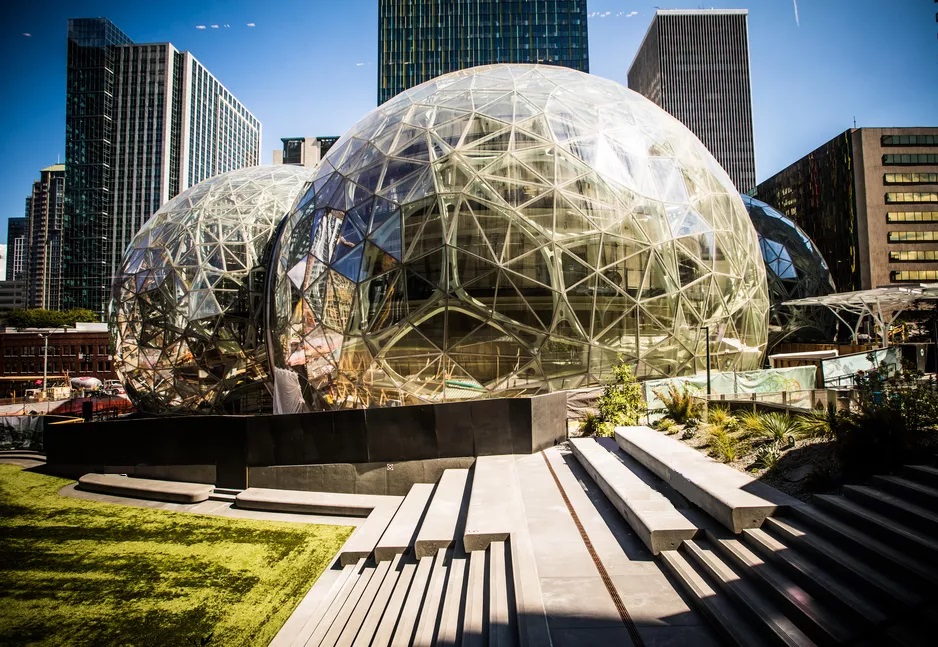
2017 was already noteworthy for its major, fever-inducing site searches to locate mega projects, led by the likes of Foxconn and other foreign investors, but the HQ2 announcement triggered a tsunami of activity.
And Amazon’s open RFP flipped the usual corporate process on its head. So unorthodox and open handed, asking cities/landowners to submit sites themselves, many accused Amazon of abusing the RFP as an opportunity to shake down cities for information—though most proposals became public info.
Cities across the country immediately mobilized their economic development teams to put together a winning proposal that could land such a game-changing/future-winning project. The ensuing weeks were genuinely exciting. You could almost feel the imagination bursting across the country as everyone in North America projected Amazon’s HQ2 concept onto their city to see how their community might make a home for the internet giant. The scramble to dust off best plans and refresh diligence reminds us how much we can be capable of when we try hard–and just how many good ideas are within reach.
But Amazon’s RFP process is not so unfamiliar. Indeed, it borrows a practice routinely deployed in the public sector.
Amazon’s “disruptive” call for proposals pinches a public-sector tactic
Most cities and municipalities are required by law to post major business for open public bid. It’s the kind of transparent process democracies rely on to check corruption and protect the public interest. It’s the same basic mechanism that makes open-call markets work. Even if you’re standing in a room full of willing deal partners, how else do you find out what the market will call out and listen for the market’s best response? But too often in the past, communities tended to go through the motions in preparing and publishing their RFPs and RFQs–putting in minimal effort and only publishing with a minimal reach.
In recent years, there’s been a trend to build more specific, structured RFP/Qs in the public sector. An increasing number of communities and economic development organizations are finding it’s worth the investment of time and effort to prepare more a thoughtful RFP/Q. Communities today are beginning to bring more sophisticated plans and projects to market and challenging developers and vendors to step up. Blessed by large budgets and staff, big cities began this new trend towards bigger and better RFPs, but small communities are getting into the act and putting together high-quality requests that call for high quality proposals and partners too. Even tiny, rural towns, like Howardville, Missouri can punch above its weight and rally to redevelop its historic high school.
With enough human resources and time, smaller communities like Howardville or Aiken, South Carolina can produce ambitious pitches for public private partnerships. This multi-site RFP for downtown development released by Aiken last year called for several specific design elements for housing, retail, office and a parking garage. Proposals from developers were also required to name the architectural firm, attorneys and engineers they would work with on the project if they their proposal were selected. The RFP even required the winning developer to agree to meet with all the business owners on the relevant block.
Notwithstanding the higher hurdles and extra hoops, Aiken’s proactive and packaged approach drew strong interest. The “Design-Build-Operate-Maintain” RFP received four substantial bids–three of which were from out of state. So, developers are not only stepping up, they’re stepping out of state to do so.
Pitching your biggest dream at peak hope with maximum effort
Amazon’s HQ2 RFP is obviously a bit different, but it’s still right in the wheelhouse of the economic development professionals who work in the space. So, with reflexive speed, elected representatives from cities like Atlanta, Boston, Charlotte, Chicago, Denver, Detroit, Frisco, Los Angeles, Memphis, Newark, New York City, Philadelphia, Pittsburgh, San Diego, San Jose, Tucson and countless more rushed into action preparing bids. “This is a transformational opportunity unlike any that we’ve ever seen,” Pittsburgh Mayor William Peduto said in a statement.
In Detroit, a project team of 59 people spent “night and day” in a conference room for 5 weeks before submitting the Motor City’s bid. Chicago’s HQ2 action team numbered more than 600.
Several cities had already been in touch with Amazon regarding the project, and internal discussions about a possible second home have already raged among executives at Amazon with rumors of favorites and preferences abuzz. But Amazon was quick to tamp down rumors and commit itself to a thorough and unbiased site selection process, telling Bloomberg that every city remains “on an equal playing field.”
“We are energized by the response from cities across North America who have already reached out to express their interest,” Amazon continued in an email to Bloomberg. “There are no front-runners as this point. We are just getting started with the process.”
There are frontrunners now. Of the 238 total proposals Amazon received, a “Top 20” list of contenders remains, all of which Amazon has officially visited (in addition to rigorous private scouting).
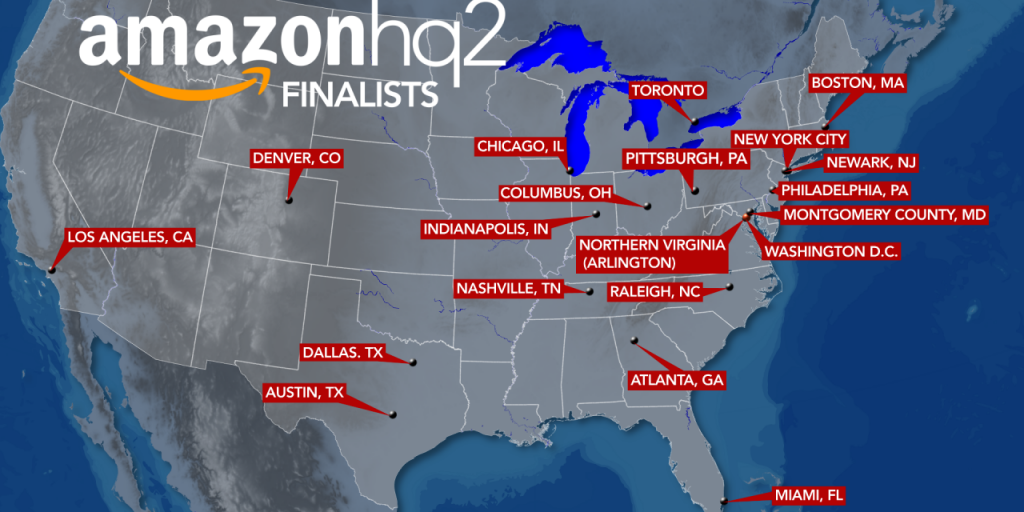
The HQ2 RFP has broken records for economic development ink spilled in speculation. Our interest in this series, however, is on substance–the how and why of what’s happening in the hunt for the ideal city and site for HQ2, which is far more instructive than simple speculation as to where it will go. Like so much of the evolution reshaping the present moment, Amazon is a signpost for the larger themes moving the world forward.
Instructive Site Selection Process
Part of the brilliance of Amazon’s HQ2 RFP is its simplicity. It’s only 7 pages. It communicates its parameters and objectives clearly. It lays out its aims in short, bullet-pointed form. So, it’s a very useful case study in any Site Selection 101 course.
The background, flux and context of the moment, noted above, is important too because of the top-to-bottom change evolving new patterns in daily business and life. Megatrends are moving for everyone, not just for Amazon. Corporate suburbia is in retreat after a century of dominance as the urban resurgence remakes city life. Aetna, GE, Marriott International, Hillshire, Kraft Heinz, McDonald’s, Motorola and many others have moved their headquarters from the suburbs to urban centers. Many other cities, such as Archer Daniels Midland and Conagra Brands, have relocated from smaller cities to urban headquarters.
Though these corporate relocation process tend to be rather opaque, Amazon’s RFP clearly states the company’s site selection criteria and guidance:
Amazon invites you to submit a response to this [RFP] in conjunction with and on behalf of your metropolitan statistical area (MSA), state/province, county, city and the relevant localities therein. Amazon is performing a competitive site selection process and is considering metro regions in North America for its second corporate headquarters. We encourage states, provinces and metro areas to coordinate with relevant jurisdictions to submit one (1) RFP for your MSA. The RFP may contain multiple real estate sites in more than one jurisdiction, but we do encourage you to submit your best sites to meet or exceed the needs of our Project…
HQ2 applicants should also represent:
- Metropolitan areas with more than one million people
- A stable and business-friendly environment
- Urban or suburban locations with the potential to attract and retain strong technical talent
- Communities that think big and creatively when considering locations and real estate options
Amazon’s RFP also stipulates the site for HQ2 should be:
- An urban or downtown campus
- A similar layout to Amazon’s Seattle campus
- A development-prepped site
And the company encouraged creative, but construction-realistic proposals: “We want to encourage states/provinces and communities to think creatively for viable real estate options, while not negatively affecting our preferred timeline.”
The ultimate HQ2 site will have massive advantages in the present economic geographic landscape and potential to leverage even greater strengths going forward.
As an expansion designed to win the future, the ultimate site and supporting community must be big enough to able to grow into Mr. Bezos biggest ambitions. And that’s big, given Mr. Bezos has his sights set on industrializing space. So, above all, Amazon’s second headquarters must be a city fit to grow into that big future.
Being bottled up, after all, is why Amazon will build the second-hemisphere of its corporate brain beyond the bounds of Seattle. “Really, there are only a few cities that could match the scale they (Amazon) need and attract additional, appropriate employees to the city,” Deputy Mayor Robert Rivkin, who’s overseeing the city of Chicago’s bid, told the Chicago Tribune. So, Amazon’s Top 20 list was not much of a surprise to most site selection professionals, though it broke plenty of hearts.
The science of site selection can cull ill-suited locations as ruthlessly and efficiently as Mother Nature can cull ill-adapted species.
Threshold for Thriving in the Amazon… and Anywhere
At peak hope, hundreds of communities that did not meet Amazon’s Top 20 threshold still took the time and heart to prepare their vision for the Amazon HQ2 in their community. Many of the 238 HQ2 proposals failed one or more of Amazon’s site selection criteria, but hope will do that.
And the effort was not wasted. It’s a good exercise to go through the motions of preparing a response. Pitching your best vision for the future of your community (or anything) challenges you to examine your strengths and weakness. It challenges your team, stakeholders and partners. Afterwards, you’ll emerge with a much clearer sense of what worked, what’s missing and next actions.
Start by taking objective measure of your data. Taking stock of your community’s quality characteristics, essential facts and key location criteria will provide the objective baseline to respond to HQ2 or any RFP. If you start up only to discover that it is difficult to define your key criteria or assemble your critical site stats, then you know it’s time to focus on developing your strategic plan. And, if you do have a lot of data, but assemble it only to discover there is no grand marketing and branding strategy that bridges your pitch together, then it’s time to build one.
Because Amazon isn’t the first and won’t be the last corporate expansion/relocation. Right now, Apple is also on the hunt for a headquarters-scale campus–whereupon the economic development community promptly swooned again. Local leaders and city staff immediately leapt into action again, dusting off the same due diligence and marketing collateral they pulled together in the months prior for the Amazon HQ2–although Apple’s criteria are not as transparent as Amazon’s. Communities dumped early from the HQ2 race may yet have a leg up on communities with no recent experience rising to the occasion of such a grand opportunity as Apple.
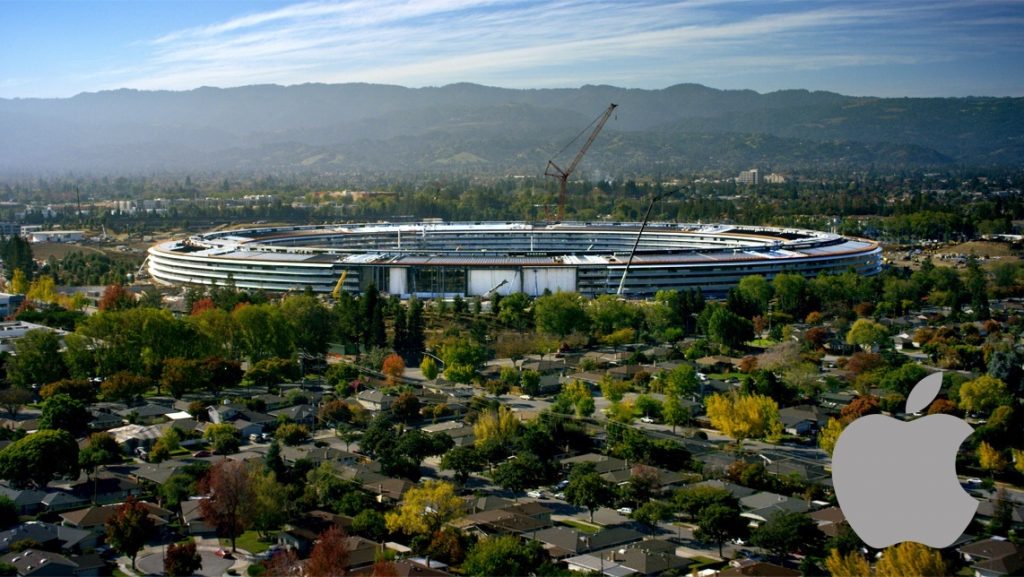
Having a firm handle on your community’s competitive position is particularly important because most corporate site selection processes are not so transparent. Companies may have criteria, but they rarely share all the details. And it’s harder pitching in the dark. So, communities must typically pitch their best selves in the hopes that the site selectors will see everything they want to see.
Fortunately, HQ2’s bullets in the RFP (above) define some hard filters that are quite useful. The right site needs size, quality of place, robust transit infrastructure and convenience for lots of workers—who today prize walkable, hands-free environments more than ever before. That’s a potent recipe, but also a tough ask for most communities. But if the final build doesn’t appeal to millennial workers, then it could be a bust or at least suffer diminished return on Amazon’s investment.
With a labor crisis well underway, attracting a quality workforce is one of today’s toughest challenges. It might be easier for a rich man’s camel to pass through the eye of a needle than to reliably hire high and sustain quality workers. But the good news for Amazon is there’s a lot of data on the labor force in the U.S., as well as most of its other key data points. And we can use this critical path item to clear a lot of HQ2 candidate communities out of contention.
Before Amazon’s Top 20 list of finalists came out, CBS News looked at metro areas where >33% of the population had a college degree or higher and found twenty-six cities fit this criteria and were large enough. With just that list in hand, you could have done well figuring out the Top 20 list, which also included cities such as Miami and Boston.
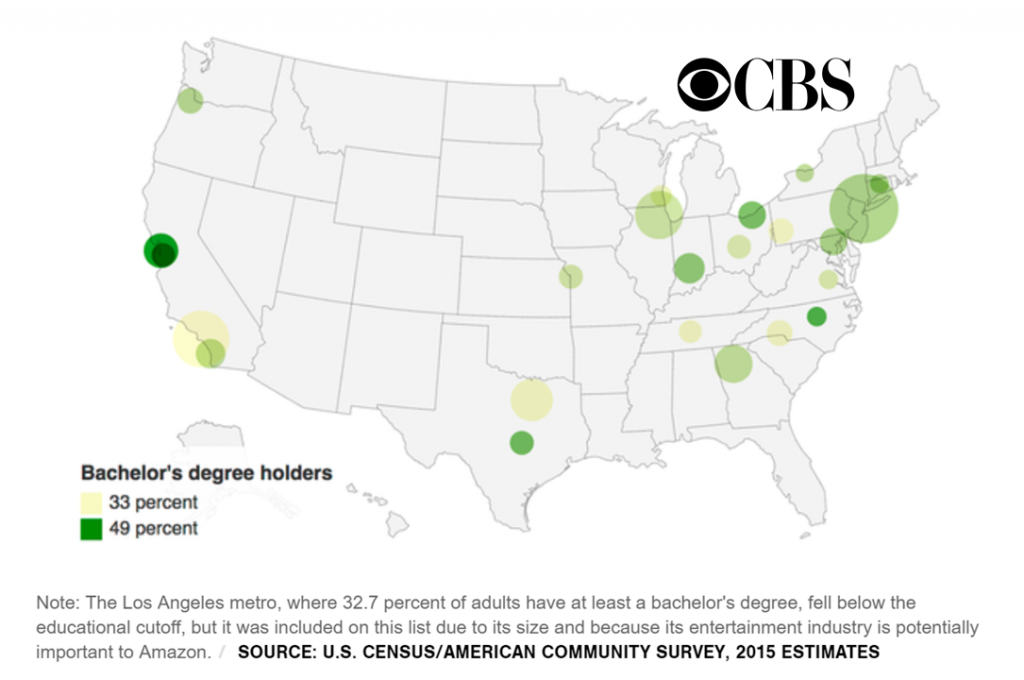
Now let’s examine Amazon’s Top 20 list using its site selection recipe and an objective eye to see how the contender communities stack up.
Handicapping the top HQ2 Candidates Alphabetically:
Atlanta
Atlanta is a clear front runner. It’s a highly populated, centrally located continental hub that anchors the Southeast region–with several other communities that have large populations and robust economies in its geographic orbit. While rather far inland compared to many of the world’s other major cities, Atlanta is connected to numerous ports in the Southeast, many of which have been booming ahead of the expansion of the Panama Canal.
Historically, it was the largest and most important city in the south, though not its political capital during the Civil War. Atlanta experienced some population loss in the 1970’s and there are now larger cities in the south, but Altana is growing again. While only the 38th largest city in the U.S., Atlanta is the core city of the ninth most populous U.S. metropolitan area with 5,268,860 people in the 2010 census.
Atlanta checks a lot boxes on Amazon’s wish list. It has the requisite size and a large workforce. Critically, Atlanta’s function as a regional capital with population density and substantial quality of place is a major advantage in the ongoing war for talent. Real quality of place is a new prerequisite to appeal to today’s historically-thin pool of human talent. And the more quality of place in close proximity and connected, the better. Because as a known commodity these days, being an attractive place to “live, work and play” is no longer a feature a community can fake.
Atlanta doesn’t have to fake it. It’s a city that got into the urban redevelopment trend relatively early and now has substantial successes under its belt. And its momentum is building.
There’s a vibrancy growing from the deep roots of talent in and around Atlanta. It’s hip, cool and bold, working to lead the future forward. Atlanta is building up it’s built-environment across the board and even constructing a pedestrian greenbelt that will eventually encircle the city and connect the region in one big loop–accommodating all the bicycles, strollers, wheelchairs and medical walkers that benefit from pedestrian-oriented development (POD) and abundant amenities.
Too much of that vibrancy is benefitting higher end segments for the co-founders of the Atlanta Beltline project, which resigned in protest of the lack of affordable housing included in the project so far. Atlanta, like many other cities experiencing robust redevelopment, is searching for answers to inclusive development whereby every income bracket can benefit from the quality of place race that’s breaking out.
From Atlanta to Anywhere
Perhaps as important to Amazon as quality of place, Atlanta is a well-established logistics hub. The city began as a railroad town and still operates as a major rail junction. Atlanta today is home to major classification yards for Norfolk Southern and CSX. It’s automobile traffic is notoriously bad, especially in rush hour and inclement weather. Nevertheless, the region maintains a substantial highway network and enjoys major interstate access with routes through to the entire region.
Then there’s the airport. Atlanta boasts one of the biggest, best and busiest international airports in the world located just seven miles south of the city’s central business district, Hartsfield–Jackson International Airport. This massive air hub would be the pride of any city and it leverages real strategic advantages for business. Hartsfield–Jackson International Airport puts Atlanta only a two-hour flight from 80% of the U.S. population, according to the city, by serving 150 U.S. destinations. It also flies to more than 75 international destinations in 50 countries.
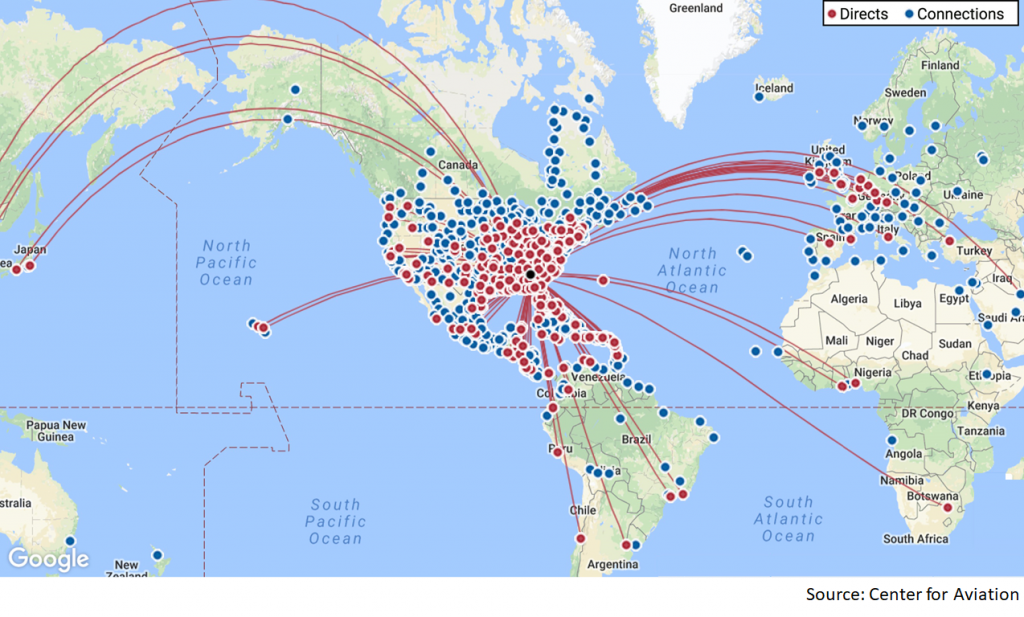
If Amazon were playing opposite corners, as in tic-tac-toe, staking a flag in a regional anchor like Atlanta would be a natural counterbalance to Seattle’s role as the logistical anchor of the northwest–minus the seaports. With headquarters in Seattle and Atlanta, Amazon would have opposite corners of country covered and span the continent’s four major time zones.
Importantly, Atlanta would not become an Amazon company town. While smaller than some of its competitors, Atlanta has big footprints and deep roots of some of America’s iconic companies, including: Coca Cola, Home Depot, UPS, Delta Airlines, Aflac, the Southern Company, Mercedes-Benz USA and CNN. 18 Fortune 500 companies in all.
And the greater Atlanta region has scored major corporate wins recently, including investments by Mercedes-Benz, Anthem, GE Digital, and Honeywell. In all, twenty-six companies headquartered in Atlanta are among the Fortune 1000.
Atlanta’s Got Talent
Atlanta is home to Georgia Tech, which is an elite research university with more than 26,000 students across a variety of applied fields. But Atlanta is also home to Georgia State University’s 50,000+ students, American InterContinental University’s 15,500 and Emory’s 15,000, Mercer’s 8,500 as well as other standout colleges like Morehouse and Spelman. Kennesaw University and Pemeriter College are also nearby; and the University of Georgia is less than an hour away in Athens.
Importantly, as Atlanta re-urbanizes, builds on its amenities and improves its transit, its ability to draw in more talent appears to be increasing. Atlanta is a top 5 talent growth market, at least according to CBRE research into net ‘brain gain’ or ‘brain drain’. CBRE’s Scoring Tech Talent in North America 2017 noted last year that Atlanta’s “strong, tech-centric universities” were a reason it rose four spots from 2016. And it held a top 5 rank for ‘brain gain’ in CBRE’s 2018 report, and ranked 9th overall.
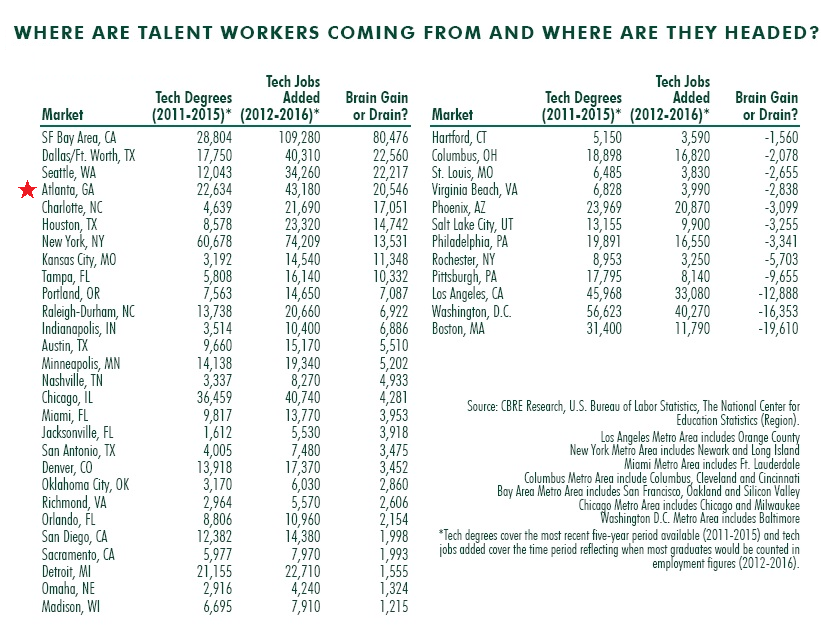
Atlanta’s “tech talent total” increased by 43,180 tech jobs between 2011 and 2016 to 133,810, second only to Seattle’s 136,910. And its growth was an impressive 47.6% over the five-year period–second only to Raleigh-Durham (with 60,900 total tech workers, up 51.3%) among cities with at least 50,000 tech workers. That growth tapered a bit in CBRE’s 2018 report, to 34.7% in the prior 5-year period, but Atlanta’s net ‘brain gain’ over that time was only outpaced by Toronto, San Francisco, Charlotte and Amazon’s own Seattle.
The Atlanta region also benefits greatly from relatively affordable real estate, certainly when compared to its coastal competition. Unlike many of its competitors, Atlanta is not generally land constrained and there’s a healthy inventory of available land and sites. Office space per square foot goes for an average of $239 and purchasing the median home will cost you $186,300, according to Zillow. Zillow calculates Atlanta’s median rent at $1,387 per month. And Zillow’s study of what effects Amazon HQ2 would have on rents in contending communities found that rents in Atlanta would likely rise a relatively small amount (0.4%) versus it’s competition, especially Denver (2.4%) and Nashville (2.4%).
Atlanta’s cool factor is heating up too. CNN put the city on the modern media map decades ago, but Atlanta’s historic and resurgent role as a cultural capital and entertainment center could also appeal to Amazon. Atlanta is in focus recently as the backdrop for multi-talented wunderkind Donald Glover’s hit show Atlanta. In it, Glover–actor, writer, producer, director and rapper/singer/songwriter (who performs musically under the name Childish Gambino)–plays a young rapper struggling to come up in Atlanta’s rich entertainment world, which in real life has produced major talents such as Outkast, Usher, John Mayer, Lil Jon, T.I. and many others. Even Elton John lives in Atlanta part time.
Historically Georgia has been a business-friendly state, but it’s support of the entertainment industry is starting to show big ticket results. Georgia’s tax credit for film, video, or digital production is helping to attract substantial investment. More films were produced in Georgia than anywhere else in North America in 2016, including California, according to a recent Film L.A. Inc. report.
Georgia’s rapid growth in the film and television industries is “remarkable,” the report notes. “With 17 projects in 2016, the first-ranked Peach State hosted nearly three times as many feature films as fifth-place New York and Louisiana,” which the report concludes is “is almost certainly due to the state’s record investment in film attraction.” And the entertainment incentives in the Peach State are sweet. Georgia set another record for spending on its incentive program: $606 million in FY2016, which is “the largest amount spent by any jurisdiction in North America or Europe on a film tax credit program in a single year” according to Film L.A. Inc. In making the record, Georgia broke its own previous best: $504 million spent in FY2015.
Depending what kind of incentives Amazon might be looking for, this uber-friendly entertainment environment could be quite appealing. Ever expanding into new segments at scale, including its own clothing label and other private label brands, Amazon’s successful Prime Video venture spent $4.5 billion on original content in 2017, according J.P. Morgan estimated Amazon. That’s only $1.5 billion less than Netflix.
Atlanta Negatives
While Atlanta has some big advantages, it has some negatives too. The metro area has 5+ million people, as we noted above, but the city itself has less than 500,000. The majority is sprawled across Atlanta’s relatively large urbanscape.
Moving lots of people across large distances by funneling everyone through the same small areas is a recipe for bottlenecks. This predictably translates into a propensity for terrible traffic conditions in Atlanta, particularly at peak usage. This could be ameliorated by multiple transit options. Unfortunately, Atlanta lacks a robust public transit system at the moment.
No surprise then, since 2008, metro Atlanta has ranked at or near the top of lists of longest average commute times and worst traffic. A 2011 Brookings Institution study placed Atlanta 91st of 100 metro areas for transit accessibility. Atlanta’s transportation system does have 47.6 miles of heavy rail (the 8th-busiest in the U.S.) working with 91 bus routes (the 14th-largest in the U.S.). But the only remaining passenger rail service beyond Atlanta is by way of Amtrak’s daily Crescent service to cities on a line between New Orleans and New York.
The warm weather city made gains by expanding to 45 miles of bike paths last year, with plans for more. The ultimate completion of its ambitious Atlanta Beltline will achieve some measure of regional pedestrian greenway network–and lay the foundation for more in the future.
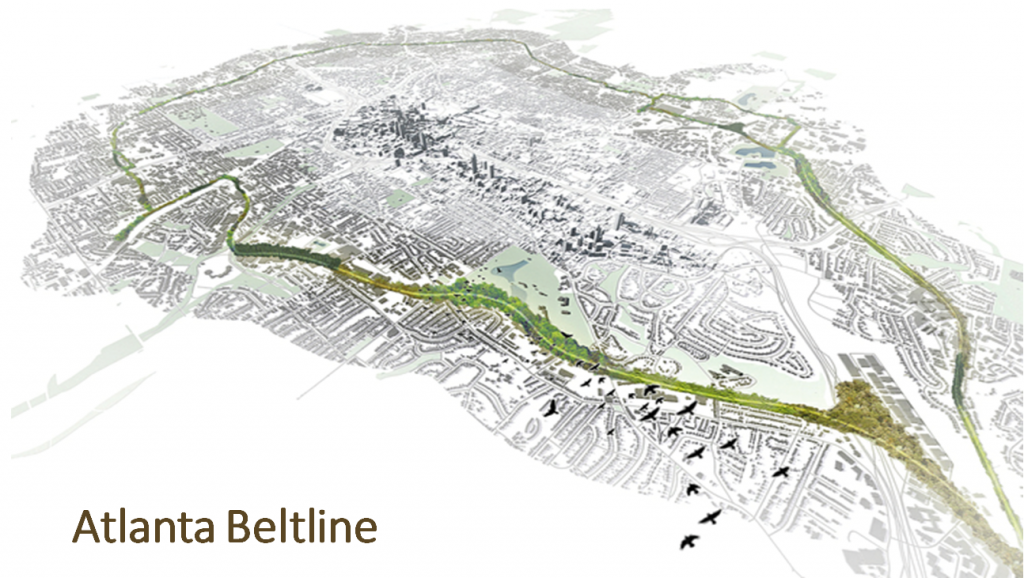
But another missing transportation piece in Atlanta is a port. This probably isn’t on Amazon’s list of must-haves for HQ2, but it is a box that Atlanta cannot check. It is linked by rail to many regional ports, including the Port of Savannah booming nearby, super-sized for the largest container ships now pushing through the expanded Panama Canal.
Suitable Sites in Atlanta
A bigger concern for Atlanta is a rather small, tactical consideration: siting the supersized campus HQ2 requires. Atlanta’s tech hub runs north, with its programmers predominantly inhabiting its northern Atlanta suburbs all the way up to Alpharetta. From a transit perspective, it’s a tech enclave with limited connectivity–unless plans for extending the Red Line from its current terminus at North Springs north towards Alpharetta come through.
There is a lot of open, developable land going north, including the “Assembly” that was a large General Motors facility in Doraville. The former auto plant is next to the Doraville MARTA Station as well as near I-285, I-85 and the Peachtree-DeKalb airport. Unfortunately, the further north you go, the deeper you’re embedding into the sprawling Atlanta region, and the further you are from the burgeoning density and public transit downtown.
An exurban campus might not be what Amazon has in mind. If it is, then maybe Stonecrest, Georgia’s pitch to create the literal “city of Amazon” has a chance. “There are several major U.S. cities that want Amazon, but none has the branding opportunity we are now offering this visionary company,” said Stonecrest Mayor Jason Lary. “How could you not want your 21st century headquarters to be located in a city named Amazon?”
For one, Amazon’s RFP requires public transit access and Stonecrest has none. Although Mayor Lary said he hopes MARTA expands rail service to Stonecrest.
What this highlights is the threat that locating in many places throughout Atlanta might raise for Amazon: straddling your people across Atlanta’s bottleneck-prone commute-scape. If it goes north, where the programmers are, it’s going away from one of Atlanta’s greatest assets, the airport, which is located seven miles south of downtown.
And in rush hours that can be a long seven miles by car. Fortunately, Atlanta has land very near one of its great assets–Hartsfield–Jackson International Airport. The City of Atlanta owns more than 100 acres at Fort McPherson, a former army base. And it sits between two MARTA stations.
Amazon could locate nearer to downtown, but it’s harder to find the right sized site for its needs. On its official site tour, Amazon scouted downtown’s Gulch and multiple sites in Midtown as part of the visit. Some Atlanta advocates have suggested bridging over I-75/I-85 to connect both sides of Georgia Tech.
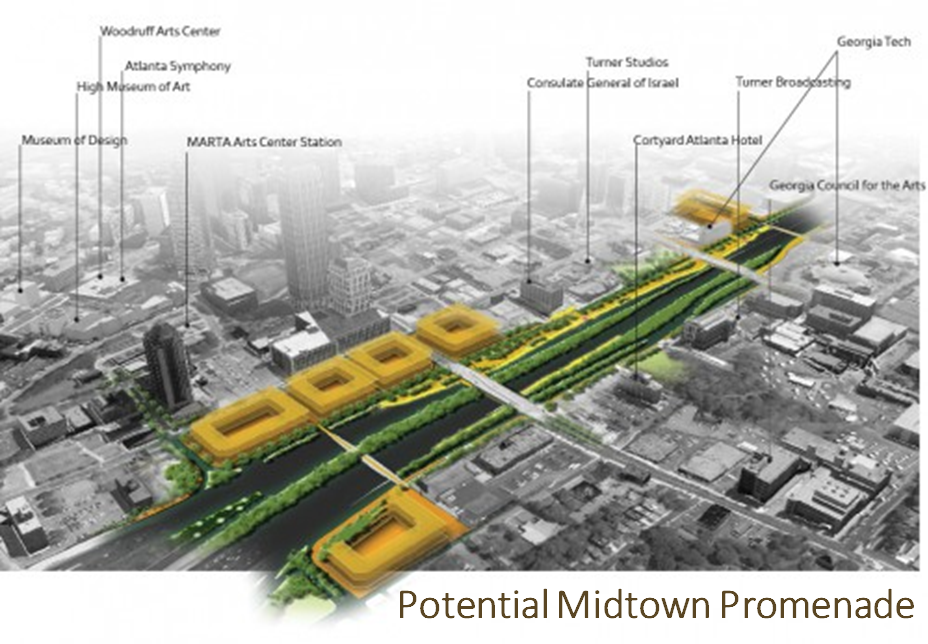
Meanwhile, a site called “the Stitch” could bridge over the Downtown Connector to create a stretch for HQ2 from the city-owned Civic Center property towards the Civic Center MARTA Station. It’s feasibility study is underway.
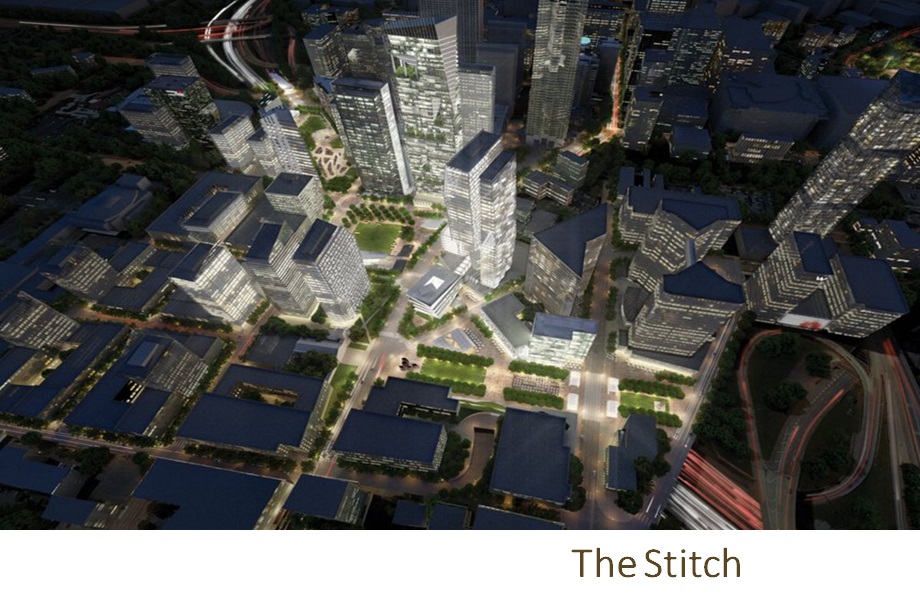
Downtown is among the most professionally conservative clusters in the southeast, which is not a political observation so much as business culture given downtown Atlanta is generally dominated by government, banking and law professionals. So, for all its cultural richness, creativity and record-breaking growth, culture could be a hard strike against Atlanta. There’s less cultural simpatico between Atlanta and Seattle as other contenders.
But Amazon knows this. The company already has corporate offices in Atlanta, as well as fulfillment centers for package delivery. Amazon’s recent acquisition of Whole Foods brought along several Atlanta area locations. And since Whole Foods is located deep in the heart of Texas, it might be a stretch to think Amazon would be scared off by cultural issues if the rest of the puzzle pieces fit. In fact, Atlanta’s cultural distinction is exactly the kind of difference Amazon hopes to assimilate into its own Amazonian super-culture.
In a statement, an Amazon said the company “is working with each HQ2 candidate city to dive deeper on their proposals and share additional information about the company’s plans. We’re excited to visit each location and talk about how HQ2 could benefit our employees and the local community.”
/end part 1
In the next issue in this series, we’ll take a closer look at some the other cities on Amazon’s contender list and see what makes them, like Atlanta, set up for success in the future economy. Not every city will receive the same attention as Atlanta–only top contenders, which Atlanta is. After cataloging each city’s strengths and weaknesses and the reasons for and against, this series concludes with our choice for ‘City of the Future’, as guided by HQ2’s RFP parameters. We’ll explore the 21st Century’s economic development recipe for success throughout and finish with a complete formula to guide any quest for a corporate campus in any community.
This long form series is only made possible by the support of Environmental Risk Information Services – ERIS.
